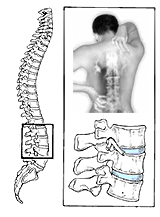 Because the muscles, ligaments, bones, discs and nerves that comprise your spinal column are so interconnected, it's often difficult to determine without a comprehensive exam and X-rays, exactly what the cause of your pain may be. Because the muscles, ligaments, bones, discs and nerves that comprise your spinal column are so interconnected, it's often difficult to determine without a comprehensive exam and X-rays, exactly what the cause of your pain may be.
Also, an injury or stress in one area, can lead to additional problems in a kind of "domino effect." For instance, a simple muscle strain may cause you to compensate by carrying your weight differently which can lead to an overall imbalance in the spine or strain on different muscles creating additional problems. Here are a few of the most common causes of back pain: |
Injury or overuse â€" If you've been injured in an auto, work, or recreational accident, get help at once . Since injury can affect muscles, ligaments, bones or discs around the spine, it's important that you get a proper diagnosis and treatment plan (if required) before the dominos begin to fall. Repetitive motion and overuse of muscles and joints due to excessive bending, lifting, or other unusual exercise can also cause damage, injury or pain. These symptoms may disappear in time, but if structural damage has occurred, they or other seemingly unrelated symptoms could flare up later. A spinal exam or assessment is recommended 
|
Nerve Pressure or Damage â€" Pressure on nerve roots in the spinal canal can be caused in a variety of ways; from injury or overuse as mentioned above or from disease or degeneration as follows: - Herniated, bulging, or compressed discs â€" Spinal discs are round, flat discs of tissue that cushion the bones (vertebrae) of the spine. If discs get damaged from injury, disease or even the normal process of aging, they can be compressed, bulged or
 even rupture. This can interfere with nerve function and create pain, numbness or weakness in the back or extremities. even rupture. This can interfere with nerve function and create pain, numbness or weakness in the back or extremities.
- Osteoarthritis â€" This refers to degeneration of the small facet joints of the spine that can cause further misalignment and pain. Typically a result of the natural aging process.
- Spinal stenosis â€" Another condition that is often a process of aging whereby the spinal canal narrows, squeezing or irritating nerves. This condition can be the result of degeneration and/or excessive bone growth or thickening of cartilage and other tissues in the canal. Left untreated, spinal stenosis can lead to serious nerve damage or even paralysis.
- Spinal misalignments called subluxations can also pinch nerves creating pain, or cause nerve interference that can actually affect other bodily functions.
|
Emotional and Physical Stress â€" Stress in life can cause muscle tension and set off a vicious cycle of pain. As muscles contract, fatigue can cause muscle aches or pain. Pain and discomfort can lead to sleeplessness with its associated problems such as irritability, depression, and reduced immune function. And so the problems perpetuate. 
|
|
 Because the muscles, ligaments, bones, discs and nerves that comprise your spinal column are so interconnected, it's often difficult to determine without a comprehensive exam and X-rays, exactly what the cause of your pain may be.
Because the muscles, ligaments, bones, discs and nerves that comprise your spinal column are so interconnected, it's often difficult to determine without a comprehensive exam and X-rays, exactly what the cause of your pain may be.
 even rupture. This can interfere with nerve function and create pain, numbness or weakness in the back or extremities.
even rupture. This can interfere with nerve function and create pain, numbness or weakness in the back or extremities.